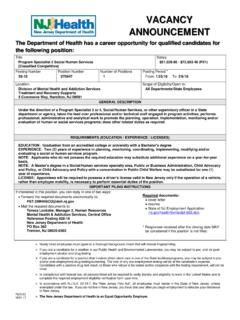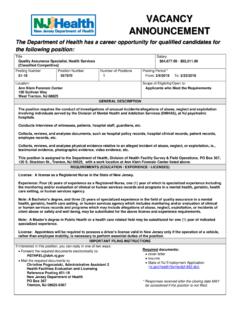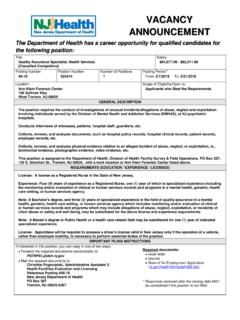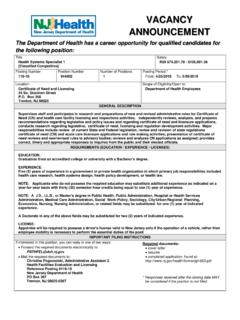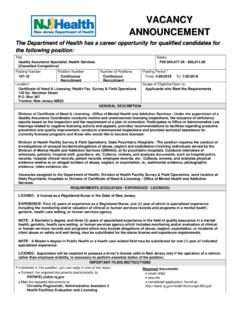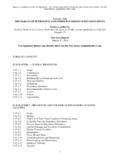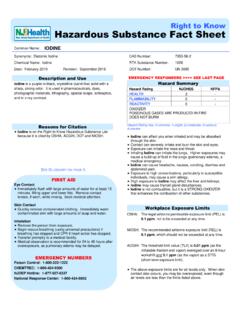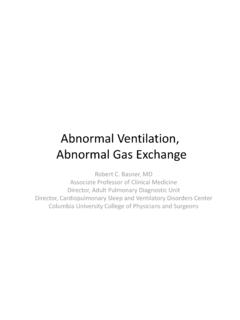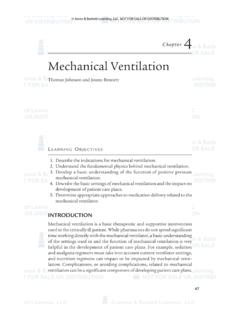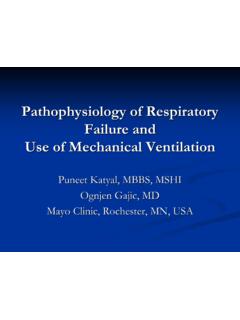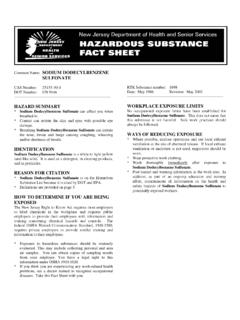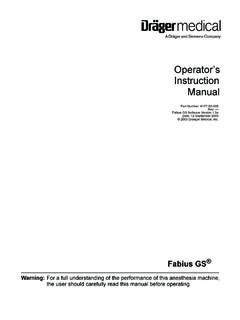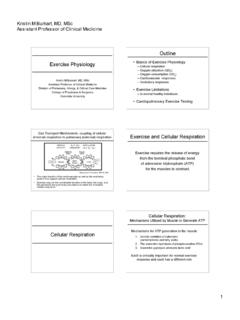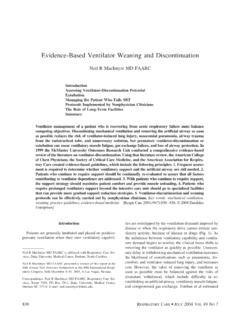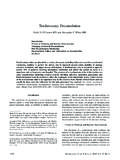Transcription of 5-FLUOROURACIL HAZARD SUMMARY 5-Fluorouracil
1 Common Name: 5-FLUOROURACIL . CAS Number: 51-21-8 RTK Substance number: 1966. DOT Number: UN 3249 Date: May 1988 Revision: June 1999. ---------------------------------------- ------------------------------- ---------------------------------------- ------------------------------- HAZARD SUMMARY . * 5-FLUOROURACIL can affect you when breathed in and by * If you think you are experiencing any work-related health passing through your skin. problems, see a doctor trained to recognize occupational * Contact can irritate and burn the eyes and skin. diseases. Take this Fact Sheet with you. * 5-FLUOROURACIL can cause nausea, vomiting, diarrhea and abdominal pain. WORKPLACE EXPOSURE LIMITS. * Exposure to 5-FLUOROURACIL can cause headache, fatigue, No occupational exposure limits have been established for dizziness and mental confusion. 5-FLUOROURACIL . This does not mean that this substance is not * 5-FLUOROURACIL may cause a skin allergy.
2 If allergy harmful. Safe work practices should always be followed. develops, very low future exposure can cause itching and a skin rash. * It should be recognized that 5-FLUOROURACIL can be * Exposure can affect the bone marrow's ability to make absorbed through your skin, thereby increasing your blood cells (anemia). Heart effects with an abnormal EKG exposure. can occur with very high exposure. * Repeated contact may cause hair loss, nail changes, WAYS OF REDUCING EXPOSURE. atrophy and a change in skin color. Exposure to sunlight * Where possible, enclose operations and use local exhaust can make these effects worse. ventilation at the site of chemical release. If local exhaust ventilation or enclosure is not used, respirators should be IDENTIFICATION worn. 5-FLUOROURACIL is a white, odorless, crystalline powder. It is * Wear protective work clothing. used as a drug to treat cancer.
3 * Wash thoroughly immediately after exposure to 5-FLUOROURACIL and at the end of the workshift. REASON FOR CITATION * The FDA (Food and Drug Administration) has set * 5-FLUOROURACIL is on the Hazardous Substance List standards for Good Manufacturing Practices for Drugs and because it is cited by DOT and EPA. Pharmaceuticals. These should be followed for your * Definitions are provided on page 5. protection as well as product quality. See the FDA. regulation 21 CFR 210. HOW TO DETERMINE IF YOU ARE BEING * Post HAZARD and warning information in the work area. In EXPOSED addition, as part of an ongoing education and training The New Jersey Right to Know Act requires most employers effort, communicate all information on the health and to label chemicals in the workplace and requires public safety hazards of 5-FLUOROURACIL to potentially exposed employers to provide their employees with information and workers.
4 Training concerning chemical hazards and controls. The federal OSHA HAZARD Communication Standard, , requires private employers to provide similar training and information to their employees. * Exposure to hazardous substances should be routinely evaluated. This may include collecting personal and area air samples. You can obtain copies of sampling results from your employer. You have a legal right to this information under OSHA 5-FLUOROURACIL page 2 of 6. This Fact Sheet is a SUMMARY source of information of all If symptoms develop or overexposure is suspected, the potential and most severe health hazards that may result from following are recommended: exposure. Duration of exposure, concentration of the substance and other factors will affect your susceptibility to * EKG. any of the potential effects described below. * Evaluation by a qualified allergist, including careful ---------------------------------------- ----------------------------------- exposure history and special testing, may help diagnose skin allergy.
5 HEALTH HAZARD INFORMATION. Any evaluation should include a careful history of past and Acute Health Effects present symptoms with an exam. Medical tests that look for The following acute (short-term) health effects may occur damage already done are not a substitute for controlling immediately or shortly after exposure to 5-FLUOROURACIL : exposure. * Contact can irritate and burn the eyes and skin. Request copies of your medical testing. You have a legal * 5-FLUOROURACIL can cause nausea, vomiting, diarrhea and right to this information under OSHA abdominal pain. * Exposure to 5-FLUOROURACIL can cause headache, fatigue, WORKPLACE CONTROLS AND PRACTICES. dizziness and mental confusion. Unless a less toxic chemical can be substituted for a hazardous Chronic Health Effects substance, ENGINEERING CONTROLS are the most The following chronic (long-term) health effects can occur at effective way of reducing exposure.
6 The best protection is to some time after exposure to 5-FLUOROURACIL and can last for enclose operations and/or provide local exhaust ventilation at months or years: the site of chemical release. Isolating operations can also reduce exposure. Using respirators or protective equipment is Cancer HAZARD less effective than the controls mentioned above, but is * There is no evidence that 5-FLUOROURACIL causes cancer in sometimes necessary. animals. This is based on test results presently available to the New Jersey Department of Health and Senior Services In evaluating the controls present in your workplace, consider: from published studies. (1) how hazardous the substance is, (2) how much of the substance is released into the workplace and (3) whether Reproductive HAZARD harmful skin or eye contact could occur. Special controls * 5-FLUOROURACIL may decrease fertility in males and should be in place for highly toxic chemicals or when females.
7 Significant skin, eye, or breathing exposures are possible. Other Long-Term Effects In addition, the following controls are recommended: * 5-FLUOROURACIL may cause a skin allergy. If allergy develops, very low future exposure can cause itching and a * Where possible, automatically transfer 5-FLUOROURACIL skin rash. from drums or other storage containers to process * Exposure can affect the bone marrow's ability to make containers. blood cells (anemia). Heart effects with an abnormal EKG * A Class I, Type B, biological safety hood should be used can occur with very high exposure. when mixing, handling, or preparing 5-FLUOROURACIL . * Repeated contact may cause hair loss, nail changes, * Specific engineering controls are required for this atrophy and a change in skin color. Exposure to sunlight chemical by OSHA. Refer to the OSHA Instruction can make these effects worse. Work Practice Guidelines for Personnel Dealing with Cytotoxic Drugs, Publication 8 - MEDICAL.
8 Good WORK PRACTICES can help to reduce hazardous exposures. The following work practices are recommended: Medical Testing Before beginning employment and at regular times after that, * Workers whose clothing has been contaminated by the following is recommended: 5-FLUOROURACIL should change into clean clothing promptly. * Complete blood count. * Do not take contaminated work clothes home. Family members could be exposed. 5-FLUOROURACIL page 3 of 6. * Contaminated work clothes should be laundered by * Engineering controls must be effective to ensure that individuals who have been informed of the hazards of exposure to 5-FLUOROURACIL does not occur. exposure to 5-FLUOROURACIL . * NIOSH has established new testing and certification * Eye wash fountains should be provided in the immediate requirements for negative pressure, air purifying, work area for emergency use. particulate filter and filtering facepiece respirators.
9 The * If there is the possibility of skin exposure, emergency filter classifications of dust/mist/fume, paint spray or shower facilities should be provided. pesticide prefilters, and filters for radon daughters, have * On skin contact with 5-FLUOROURACIL , immediately wash or been replaced with the N, R, and P series. Each series has shower to remove the chemical. At the end of the three levels of filtering efficiency: 95%, 99%, and workshift, wash any areas of the body that may have Check with your safety equipment supplier or your contacted 5-FLUOROURACIL , whether or not known skin respirator manufacturer to determine which respirator is contact has occurred. appropriate for your facility. * Do not eat, smoke, or drink where 5-FLUOROURACIL is * If while wearing a filter or cartridge respirator you can handled, processed, or stored, since the chemical can be smell, taste, or otherwise detect 5-FLUOROURACIL , or if swallowed.
10 Wash hands carefully before eating, drinking, while wearing particulate filters abnormal resistance to smoking, or using the toilet. breathing is experienced, or eye irritation occurs while * Use a vacuum or a wet method to reduce dust during wearing a full facepiece respirator, leave the area clean-up. DO NOT DRY SWEEP. immediately. Check to make sure the respirator-to-face seal is still good. If it is, replace the filter or cartridge. If PERSONAL PROTECTIVE EQUIPMENT the seal is no longer good, you may need a new respirator. * Be sure to consider all potential exposures in your WORKPLACE CONTROLS ARE BETTER THAN workplace. You may need a combination of filters, PERSONAL PROTECTIVE EQUIPMENT. However, for prefilters or cartridges to protect against different forms of some jobs (such as outside work, confined space entry, jobs a chemical (such as vapor and mist) or against a mixture of done only once in a while, or jobs done while workplace chemicals.)
